Nolan is Dividing 2 by 11 If He Continues the Process What Will Keep Repeating in the Quotient
Division using the standard algorithm often takes time to teach and can be difficult for students to fully understand. It doesn't have to if you have the right long division teaching strategy in place.
In this blog, Sophie Bee (@_MissieBee) explains the long division method her class now follows, how to teach long division with ease this way – and even better, how to ensure your students start to love their new long division technique.
Long division: long and divisive, right? Wrong!
Long division is probably one of my favorite things to teach in math (I know, I know – but bear with me).
When children watch you do it, they think it looks complicated, difficult and unnecessary, and it almost instantly turns them off – until they realize how systematic and logical it is.
See also: Divisibility rules
What is long division?
Long division, also known as the standard algorithm for division, is a method for dividing one large multi-digit number into another large multi-digit number.
Students first encounter the partial quotients method in 4th grade (up to 4-digit by 1-digit) and 5th grade (4-digit by 2-digit). This lays the foundation for long division.
In 6th grade, long division usually means dividing a number that contains up to 4 digits by one that contains 2 digits, providing a whole number quotient, leaving a remainder, and sometimes with the need to provide an answer to decimal places or as a fraction.
As well as recognizing the division symbol before they tackle long division, children should understand terms like the dividend and the divisor.
- The dividend is the number you are dividing.
- The divisor is the number you are dividing by.
- The quotient is the amount each divisor receives, i.e. the answer in most cases.
If you feel you need a brush up on all the precursor stages to long division, then this article for parents on division for kids is a great start.
What is the long division method?
The formal long division algorithm is a step-by-step method of supporting children to understand both conceptually and practically how to divide a multi-digit number by a one or two-digit number.
The steps of long division are set up in a similar way as the partial quotients method, but a memorable process is used to get to the answer. First you divide, then you multiply, then you subtract, and then you bring the next digit down. This process is repeated until you have reached a solution.
- Divide
- Multiply
- Subtract
- Bring the next digit down
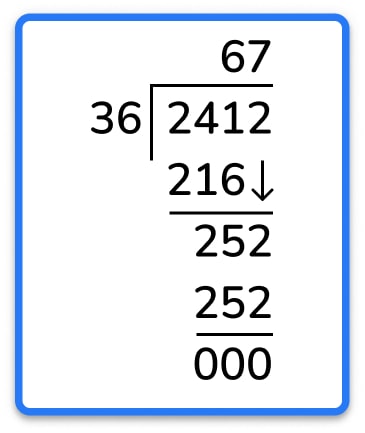
If you want to know how to teach this long division method, please read on.
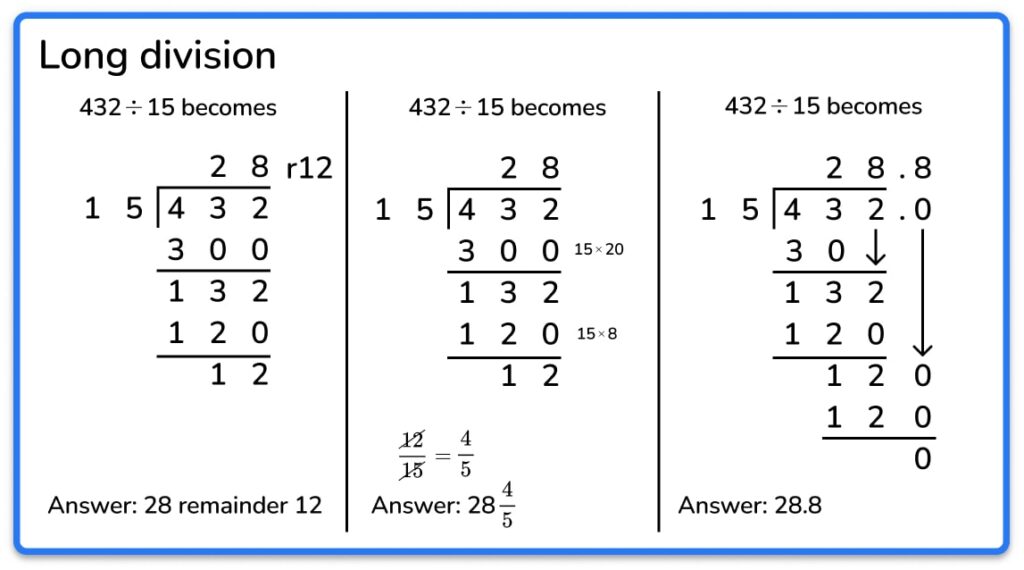
Partial quotients method
The partial quotients method for long division with two-digit numbers is set out in the first two columns below; it encourages children to think about the relationship between multiplication and division by estimating first how many times the divisor is likely to go into the dividend.
Long division (standard algorithm)
The long division method in the third column is my favorite and the one I recommend we should all be teaching all students by following the steps below!
"Your favorite and best long division method looks too hard for my elementary kids!" I hear you shout!
I admit, when I first started teaching 5th Grade, I shied away from this long division method for a long time.
I'd never understood it properly, yet always considered myself a competent mathematician, so didn't really understand the need for it.
It wasn't until I sat down and decided to teach myself the method that I realized how systematic it was, and how it really embedded what was happening in each step of the division process – something that would be really useful both for those that struggle with mathematical concepts and for those working with decimal points and larger numbers.
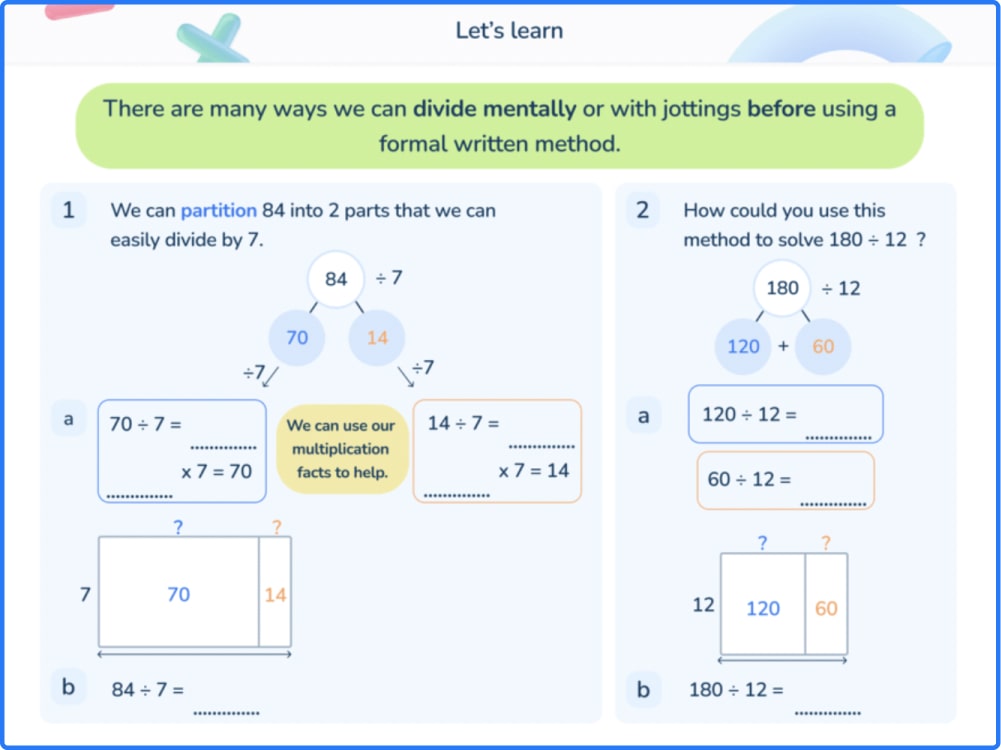
Why you should teach the formal long division method (standard algorithm) at elementary school
A short personal story to show you that this long division method can work is that in the days leading up to the state tests last year, I was very conscious of one of my 'bubble' children – you know the ones – who really struggled with confidence and general understanding in math.
I took a sneak peek at them completing a long division question on a math paper and watched them methodically work their way through it to achieve the correct answer. This was someone who didn't know their times tables at the start of the year, and I could've burst with pride! It was a case of long division made easy at last for this elementary student, all thanks to the long division method explained below!
But Doesn't Long Division Take Too…Well…Long?
Okay, so the name of the method doesn't really help in selling itself, but, once you're fluent, it should take the same amount of time (if not less) than the 'partial quotients method.' See the long division examples below, dividing 45,041 by 73. First we show the partial quotients method and then the long division method.
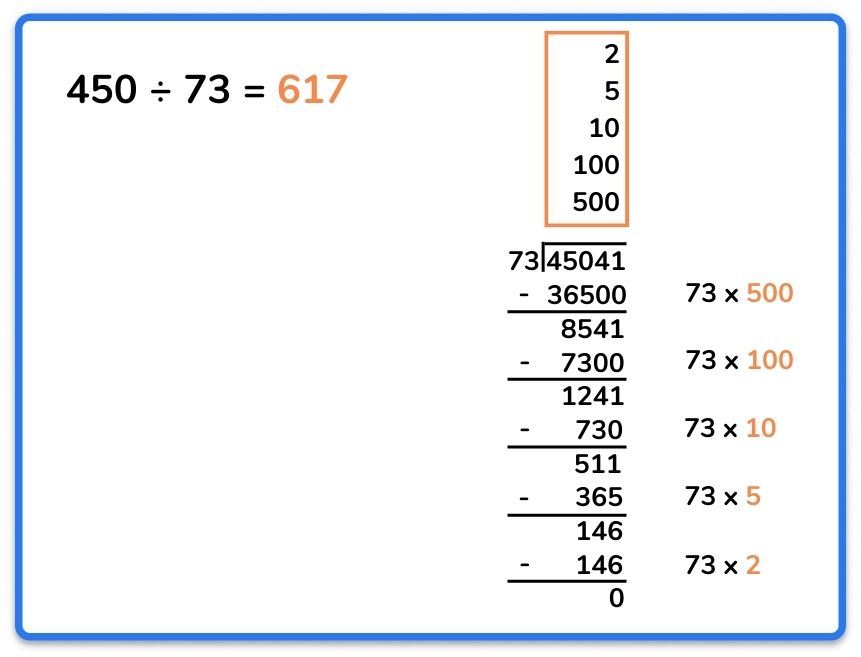
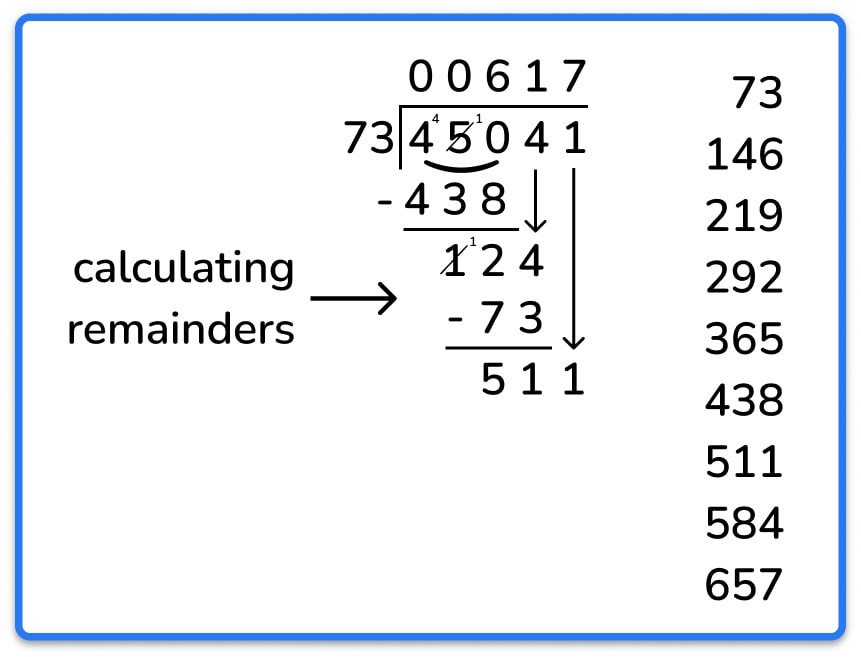
With short division, children still need to work out the remainders.
Many will need to do this via written subtraction anyway, and even if they can calculate them mentally, we all know how many mistakes are made by overconfident children when working at speed – especially when they refuse to write out their work!
If anything, the long division method took less time as I didn't have to write out each partial quotient, as well as its corresponding multiplication equation, before adding them together.
How to teach the formal long division method
Fear not! This is my tried and tested long division method when teaching 5th Grade.
On average, it would take me around three days, but as we all know, this completely depends on the cohort, so I've broken the process down into 'steps' instead, to be spread across as many lessons as needed. Warning: multiplication tables/grids will be required!
What are the steps for teaching long division?
In a nutshell, this is what you're going to be teaching your students:
- Recap and explain the partial quotients method
- Divide
- Multiply
- Subtract
- Bring the next digit down
Here it is broken down
Long Division Method: Step 1
Recap the partial quotients method, ensuring children can talk through the process. Do they understand what's happening at each step? For example, you could ask:
- What is the divisor?
- Why is it important to know multiples of the divisor?
- What is a remainder?
- How have you calculated the remainder?
- What happens if you get a remainder at the end of the question?
- How can you check if your calculation is correct?
Once children are confident with the partial quotients method, they can move onto long division.
Long Division Method: Step 2
Dividing by 3 isn't so scary, but dividing by 97 is much more intimidating!
I'll always start this lesson by asking children to list the first nine multiples of a 'difficult' number (such as 86) and watch them groan and do lots of column addition or counting on fingers or something else equally as inefficient.
Of course, there are occasionally those that know their multiplication and division facts and can whizz through these – I know a few children who would quickly list multiples of 97 by adding 100 and subtracting 3 each time, but until we have a class full of children that can do that without prompting, this method will be worth it!
I then show them how to do it by partitioning and it's sometimes one of those moments where if a cartoon light bulb could appear above their heads, it would (cue a chorus of "Ohhhhhh yeahhhhhh!"s).
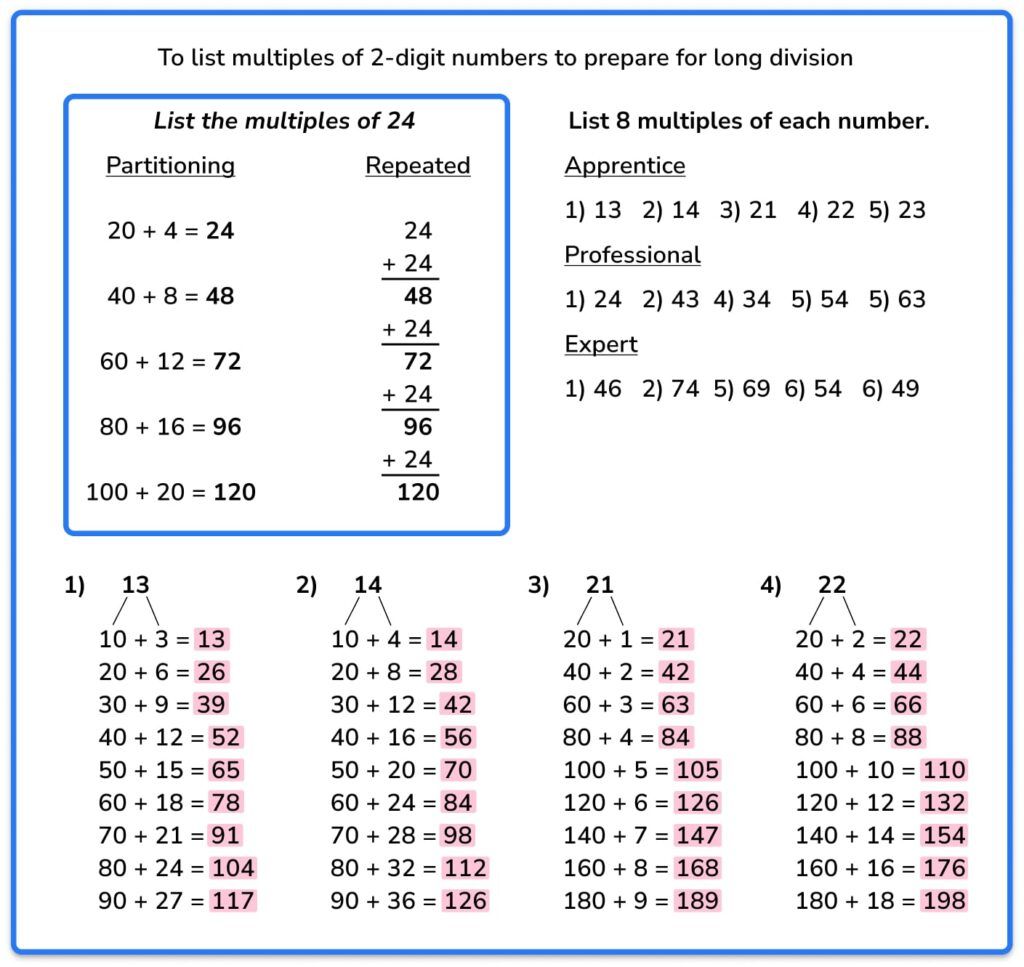
This may be a new approach for you but the first time I did this, it was one of those lessons which on the face of it looked intensely boring, but my 5th Grade children got so carried away with their partitioning for long division that they even asked to stay into their lunchtime to finish the questions!This just proves that engagement in lessons isn't created from bells and whistles, but listing multiples in preparation for long division – you heard it here first!
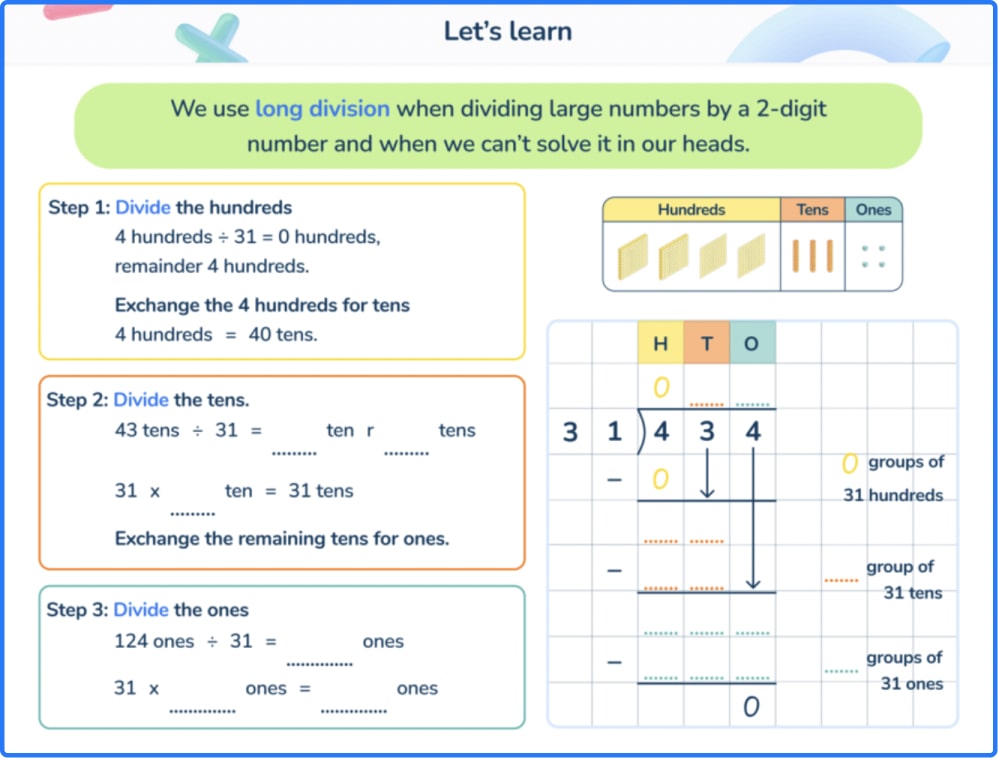
I ask the children to list nine multiples every time – asking them why you would only need nine multiples for any long division question is a good way of obtaining their understanding of the division process. Obviously, as they gain confidence in the method, they only need to list as many as necessary.
Long Division Method: Step 3
This is where I bring in the good old 'me, we, you' process.First, I show them a completed modeled example:
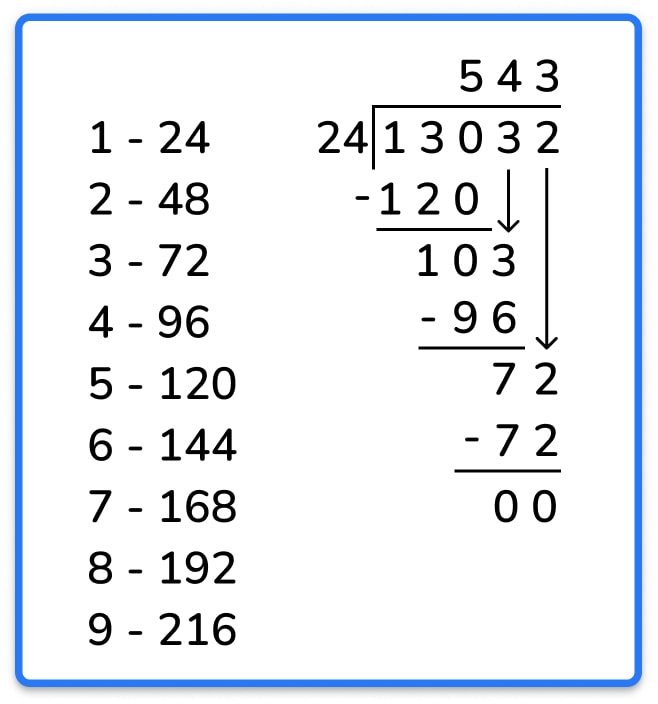
Then, I complete the division myself (next to the modeled long division example) to show them how I achieved it, always talking through each step as I go. This is usually when you get the "What?", "Miss, I don't get it", or, "That's impossible" comments; it doesn't take much to change their minds! Remember to work slowly through from the first digit of the dividend.
Explaining this formal long division method as you go is very important to cement understanding among all students.
It's important to explain the steps broken down: to divide, multiply, subtract, then bring the next number down.
I encourage the children to write the four symbols down on their page to remind themselves of the steps. They should have a solid understanding of these steps as, apart from the last one, they are the same as the partial quotients method:
• Divide: how many times does the divisor fit into the number without remainder? (use the list of multiples)
• Multiply: multiply the answer to your previous division by the divisor to reach the multiple needed to calculate the remainder (use the list of multiples)
• Subtract: subtract the multiple from the original number to calculate the remainder
• Bring the next digit down: this replaces the 'write the remainder just before the next number' step in short division
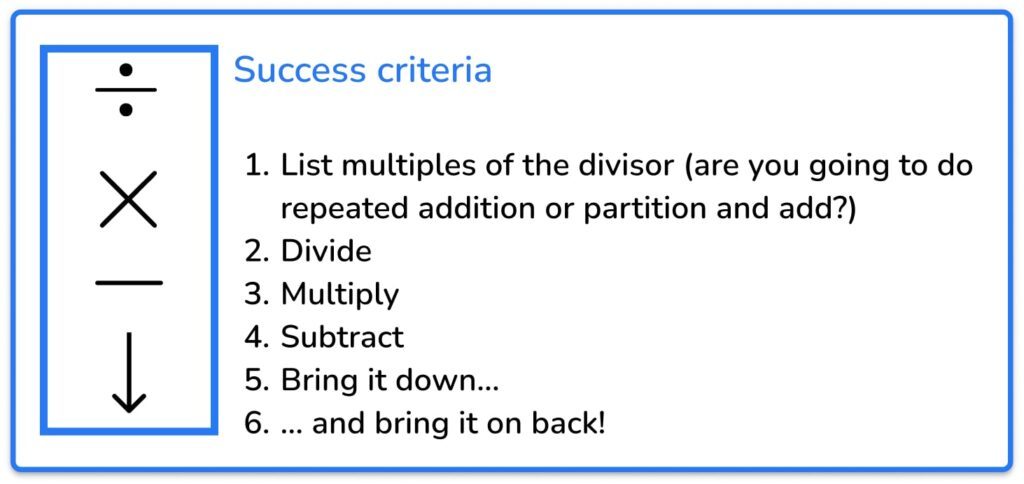
Long division step by step using an exemplar question
Let's take the modeled long division example, 13,032 ÷ 24 (assuming we've already listed the multiples as in the modeled example in Step 3); this multiplication step is important.
1: Divide: 130 ÷ 24 → 24 goes into 130 five times (I can see by looking through my list of multiples that 130 would be placed between 120, the 5th multiple, and 144, the 6th multiple).
Note: as we're working digit by digit from left to right, we can see that 24 doesn't fit into 1 (the first digit), therefore a 0 is placed above it; it also doesn't fit into 13 (the 1st and 2nd digit combined), therefore another 0 is placed above it. We are now working with 130 (the first three digits combined) which has ensured that all the place values are correctly aligned.
2: Multiply: 5 lots of 24 is 120 (I should know this from the answer to the previous step, but I can also count down my list of multiples to find the 5th multiple of 24). This is the number we need to work out the remainder to our first division (130 ÷ 24).
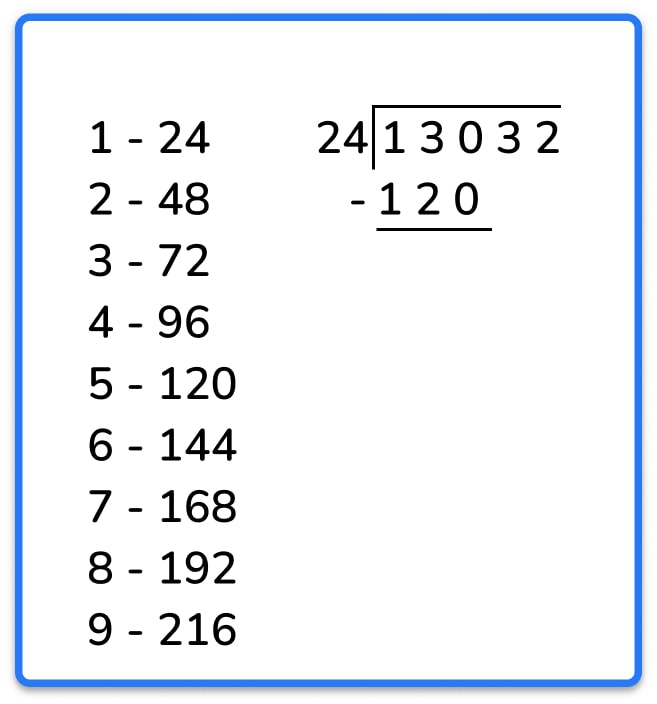
3: Subtract: 130 – 120 = 10, so this is the remainder to the first division (130 ÷ 24). This needs to be included in our next step.
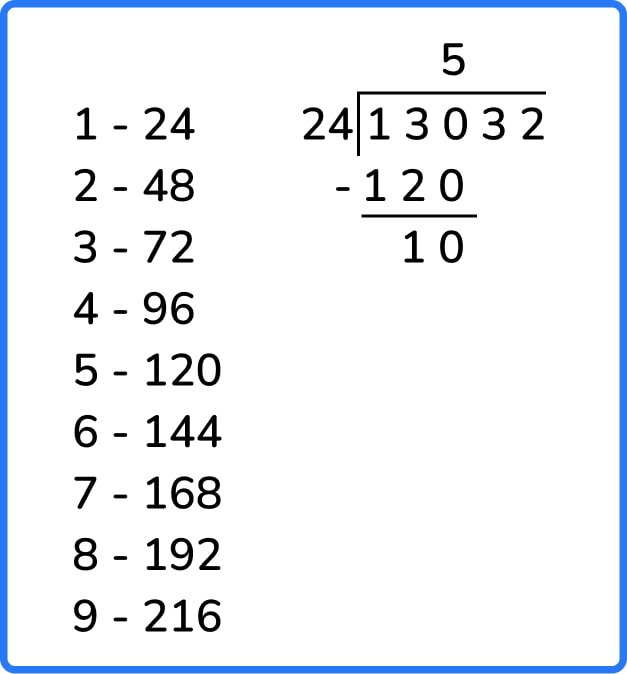
4: Bring the next digit of the dividend down: bringing the 3 down makes my new number 103. I'll then repeat the process again.
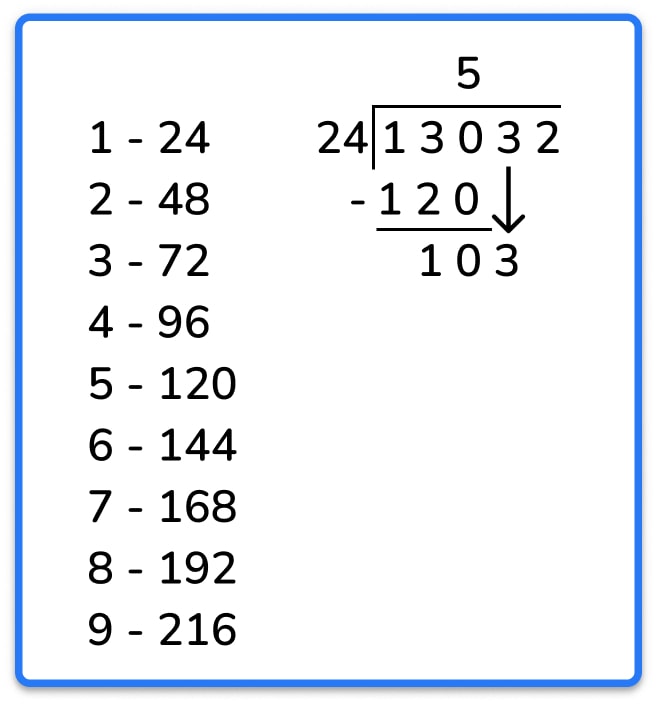
5: Divide: 103 ÷ 24 → 24 goes into 103 four times (I can see by looking through my list of multiples that 103 would be placed between 96, the 4th multiple, and 120, the 5th multiple).
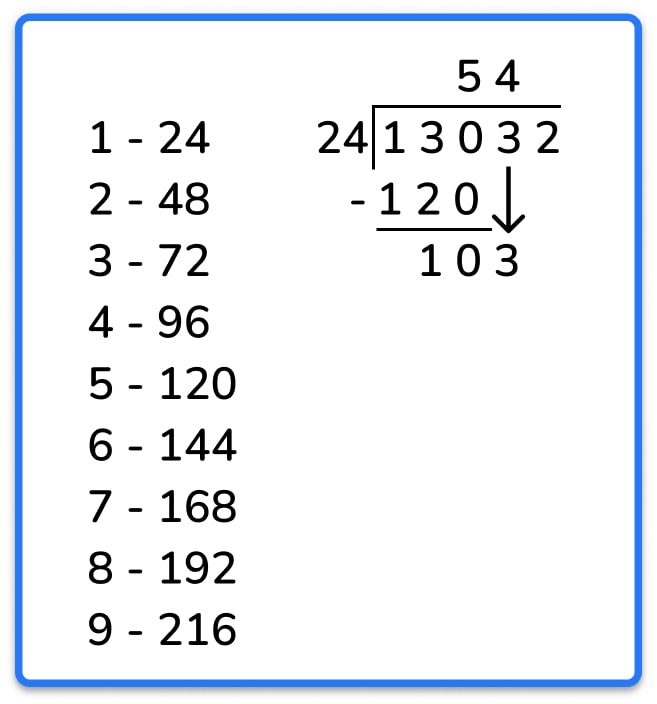
6: Multiply: 4 lots of 24 is 96 (I should know this from the answer to the previous step, but I can also count down my list of multiples to find the 4th multiple of 24). This is the number we need to work out the remainder from the second division (103 ÷ 24).
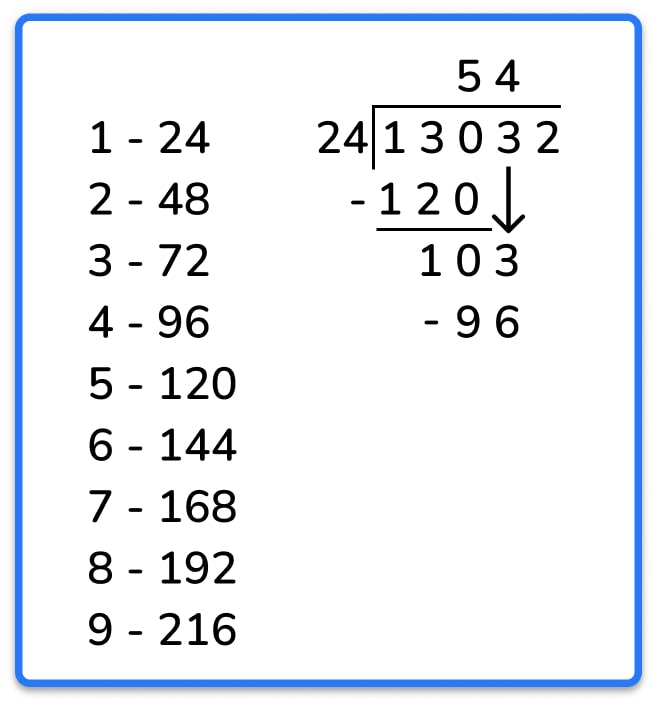
7: Subtract: 103 – 96 = 7, so this is the remainder to the second division (103 ÷ 24). This needs to be included in our next step.
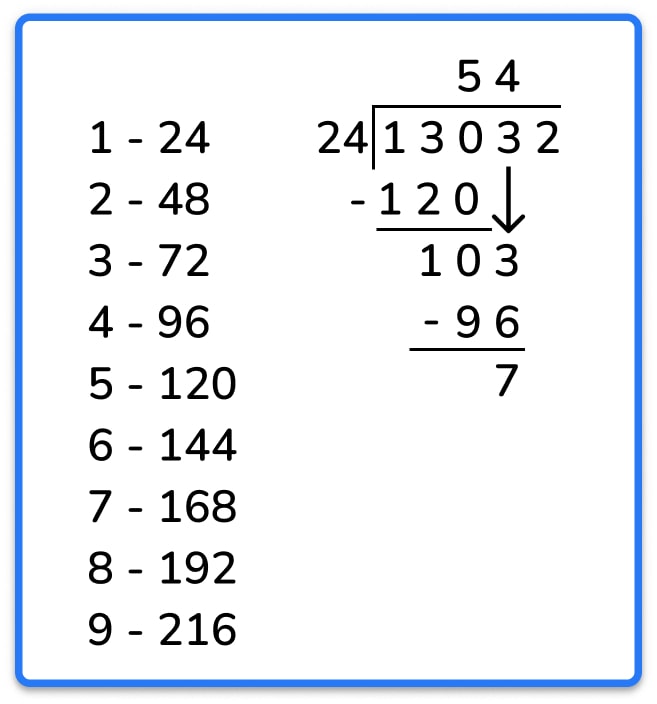
8: Bring the next digit down: bringing the final digit down creates my final number to work with: 72
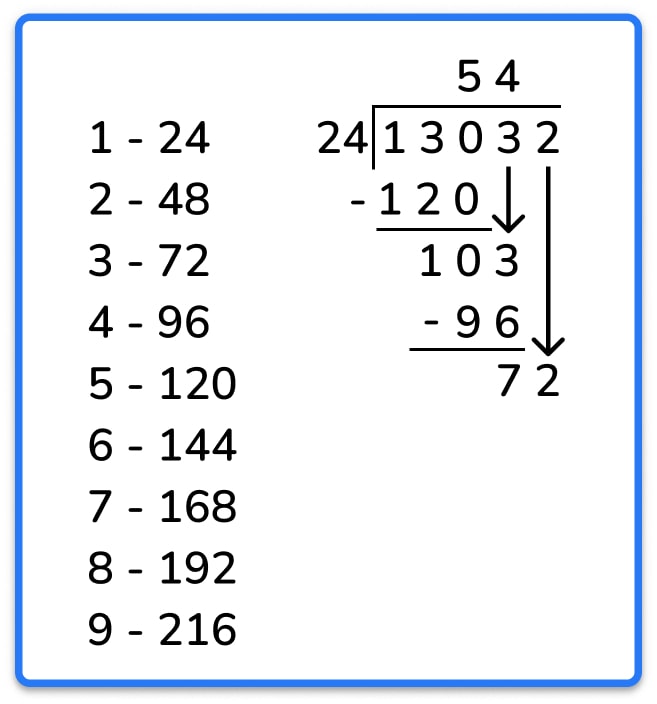
9: Divide: 72 ÷ 24 = 3
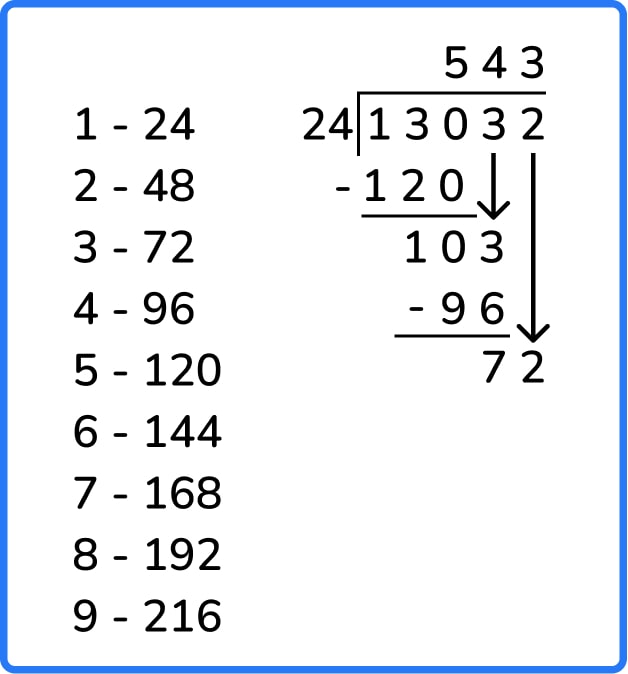
10: Multiply: 3 x 24 = 72
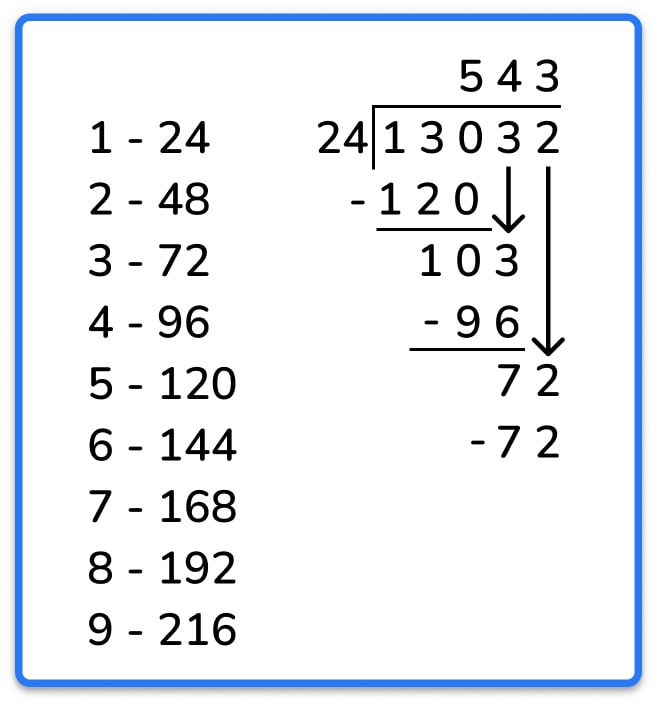
11: Subtract: 72 – 72 = 0. There is no remainder, so we know that the divisor must fit into the original number exactly. So our final answer is 12,032 divided by 24 is 543.
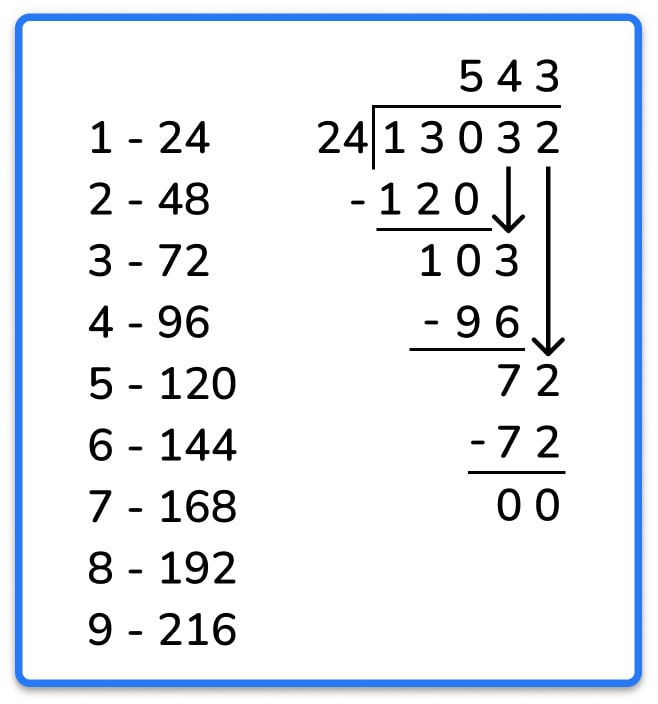
How you can get your class to check their own work
Of course, like in any activity the children do, it's important to encourage them to check their own work.
They can do this by multiplying their answer by the divisor to see if the original number is produced. In this case, 543 x 24 = 13,032, so we know that we are correct.
If they don't get the original number as their answer, I've found that the most common mistake the children make is either listing the multiples incorrectly or misaligning the place values (meaning they may have calculated one of the steps with the wrong numbers).
Numerous students making this latter mistake might indicate that they need to review the fundamentals of place value.
Read more
- How to Teach Division
- How to Teach Multiplication
- The Best Way To Teach The Long Multiplication Method
So, now you've taught it, but of course, you won't yet be confident they've learned it, so the final stage in consolidating long division is practicing it.
Long division examples
Here are two long division examples laid out for you:
Example 1. 288 ÷ 12 = 24
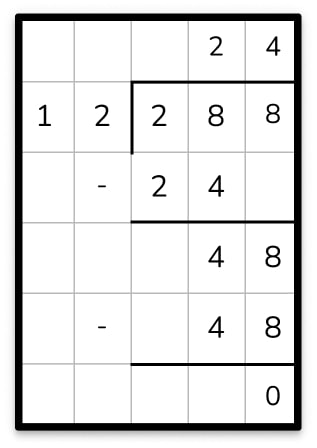
Example 2. 384 ÷ 12 = 32
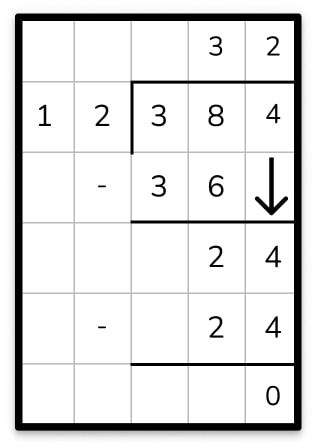
Long division questions
Do loads of long division questions! You can do them together on whiteboards and slowly take away the help. Then, when the children are ready, they can work independently.
Build up their complexity as you go; below are just six questions, ordered in increasing difficulty.
- 2,574 ÷ 11 = ?
- 1,476 ÷ 12 = ?
- 4,096 ÷ 16 = ?
- 4,488 ÷ 17 = ?
- 13,528 ÷ 38 = ?
- 18,473 ÷ 49 = ?
In my classroom, this works as a 'peeling away' process, which often looks like this: input to the whole class for 5 minutes – 2 or 3 children set off to work independently; input to the rest of the class for a further 5 minutes – another few children set off to work independently; input to the rest of the class for a further 5 minutes – another group of children set off to work independently.
I'm then left with those requiring the most support in long division, with whom I stay and support while the rest of the class works independently, before we all regroup at the end of class.
Long division reasoning questions
Once children are confident with their long division questions, reasoning activities can then be introduced, such as long division with missing digits, or 'spot the mistake/s', moving on ultimately to worded long division problems.
A way to incorporate reasoning skills into division is to ask students to "interpret the remainder" while solving division word problems. Students will need to assess the word problem and decide how to interpret the remainder:
- Drop it: Ignore the remainder and use only the quotient as your answer
- Add it (also known as Round it): Add one more to the quotient (or round up)
- Share it: Equally distribute (share) the remainder as a fraction or a decimal
- Use it: Use the remainder as your answer (this is used when a problem asks something like "how many are left over?")
Below are a few examples of "interpreting the remainder" division problems for 4th, 5th, and 6th grades where students can use long division to solve.
Long division for 4th graders
Fourth graders are expected to find whole-number quotients and remainders with up to four-digit dividends and one-digit divisors.
Long division problems for 4th graders
Drop it
Mrs. Lopez is organizing a shipment of new books onto an empty bookshelf in the library. There were 794 books in the shipment. There are 9 shelves. How many books will go on each shelf if Mrs. Lopez wants each shelf to have the same number of books?
Students do not need to use the remainder in this problem, so the answer will be 88.
Use it
After trick-or-treating on Halloween, Nolan and his six friends pool all their candy together and then divide it equally between the seven of them. Altogether, they had 1,032 pieces of candy. They give any remaining candy to Nolan's little sister. How many pieces of candy did Nolan's sister get?
In this example, students are asked how many pieces remain after completing the division, so the answer to this word problem is 3, which is the remainder.
Long division for 5th graders
Fifth graders are expected to find whole-number quotients of whole numbers with up to four-digit dividends and two-digit divisors.
Long division problems for 5th graders
Add it
All third, fourth, and fifth grade classes are taking a field trip. Each bus can carry 52 students. If there are 1,341 students, teachers, and chaperones riding the buses to the field trip, how many buses will be needed?
In this example, students will need to add 1 or round up the answer. Since 1,341 ÷ 52 = 25 remainder 41, the answer would be 26 buses. The remainder represents 41 people who also need to ride a bus, so we would need an extra bus to fit everyone.
Share it
Xander made $1,519 this summer mowing lawns. In total, he mowed 98 lawns. How much money did he make per lawn?
In this example, we split our remainder. The remaining 49 parts can be divided into 98 equal parts, so instead of 15 remainder 49 – our answer is $15.50.
Long division for 6th graders
Sixth graders are expected to divide multi-digit numbers and multi-digit decimals using the standard algorithm.
Long division problems for 6th graders
Share it
A team of 40 engineers enter a competition and win a prize of $2,135,010. If the prize is to be split equally among them, how much money will they each receive?
2,135,010/40 = 61,000 R10 which converts to $61,000 and $10/40 = $61,000 and $1/4 each which is $61,000.25.
Of course, ultimately, if you don't feel confident with this long division method, it will never translate effectively to the children; as with anything in teaching, it must work for you and your class.
However, knowing that this is often a topic hotly debated on Edu-Twitter and Edu-Facebook, I hope I've converted some people to the long-division-loving side!
Happy dividing!
Source: https://thirdspacelearning.com/us/blog/teach-long-division-steps/
0 Response to "Nolan is Dividing 2 by 11 If He Continues the Process What Will Keep Repeating in the Quotient"
Post a Comment